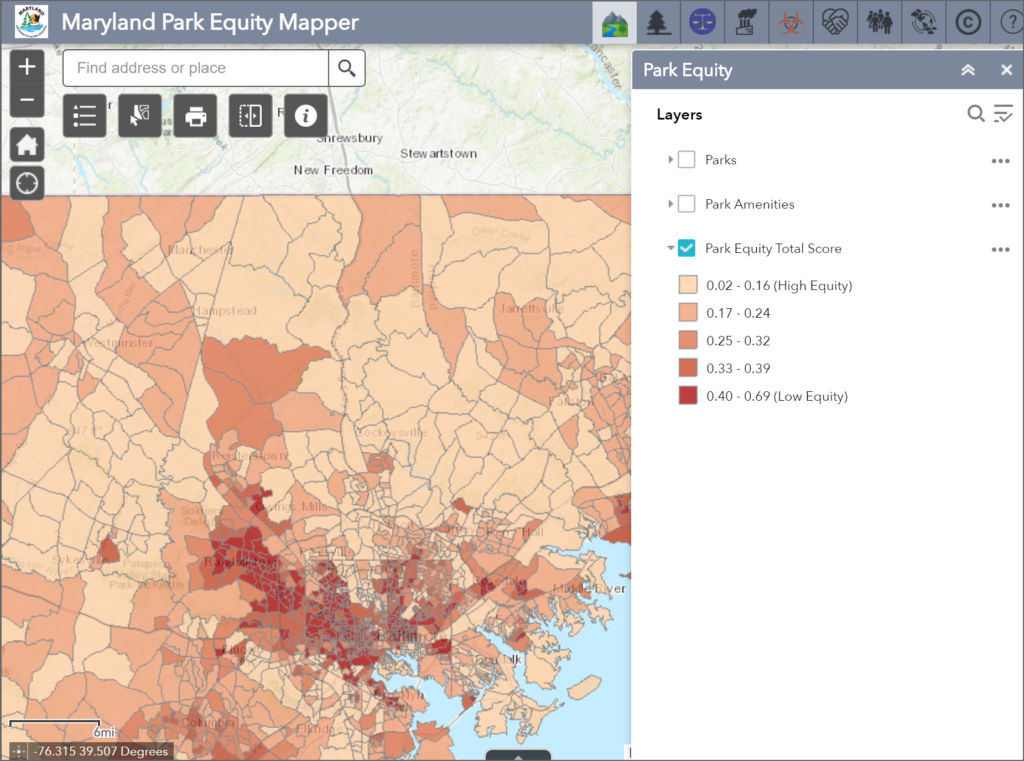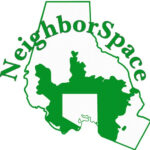What’s Behind the Inequitable Distribution of Open Space in the County and What Can Be Done About It?
This week, while going through my blog feeds, I came across something that gave me pause. It was a post by the Project for Public Spaces (PPS) on the topic of “equitable development.” The upshot of the piece was this: “While ending police violence may be one of the most urgent needs, systemic racism infects our society in many ways, from our governmental policies to our systems of investment to our workplaces to the ways our public spaces are distributed, designed, and operated.”
The piece also got my attention because, a few days ago, the Maryland Department of Natural Resources (DNR) issued a press release about a new tool, “Maryland Park Equity Mapper.” This GIS tool is designed to identify areas across the state in need of public park space. The rationale for it is that “parks provide opportunity for physical activity, stress reduction and social interaction and are fundamental components of healthy, vibrant communities. Promoting park equity is one way to ensure communities--regardless of socio-economic, demographic, or geographic profile--have equal opportunity to a healthy environment.”
Just as our own GIS mapping has demonstrated, the Equity Mapper shows that there are huge areas on the west side of the county and additional areas on the east side where inequity in the distribution of parks prevails. How did this happen? (Hint: It has something to do with inequity in the development process). More importantly, what can be done about it?

I won’t pretend to know all of the reasons or to have all of the answers. I am going to speak, instead, here, to what I have learned in 11 years of working with NeighborSpace about how open space is provided through the development process in Baltimore County. Here’s my take:
WHAT’S BEHIND THE INEQUITY?
(1) By Favoring the Creation of Open Space Over Payment of a Fee, We End Up Creating Open Space in Places Where It is Needed Least
Our law currently favors the creation of open space either on a development site or off-site over payment of an open space waiver fee. The obvious problem here is that, for the most part, development is not happening in places where inequities exist. So the space that gets provided does nothing for the communities that need it most.
Our law also allows developers to provide off-site enhancements as a way of satisfying the open space requirement. If you guessed that these also do not go where inequities exist, you’d be 100% on the money. Most often, these are sprinkled around to groups and communities near the development site to curry favor among them for the project. In a recent example, a $340,000 open space fee will be spent across the street from the development site in two existing communities on things such as a polygon community shade structure, picnic tables, grills, sidewalks, tot lots and exercise equipment. (See Resolution 59-20 passed by the County Council in June). Absent pressing questions of equity and open space deficits, I might take no issue with this list; the problem, however, is that $340,000 spent in this way is $340,000 that can’t be spent to provide open space where it is most needed. And, as the map below shows, there are incredible needs elsewhere in the 1st Councilman District where this project, known as Patapsco Fields, is located. The dark blue areas are the places where the social needs for open space (e.g., open space deficit, presence of vulnerable populations, volume of multi-family housing) are highest. The pink outlined objects are the highest value vacant lands, which might be acquired to address the social needs. They are surrounded by a circle with a radius of ¼ mile, the distance someone is typically willing to walk before thinking about driving. Could the opportunity cost and inherent unfairness of our current law be any clearer?
(2) A Law Designed to Generate More Equitable Fees is Not Being Followed
A law designed to generate fees based on the open space needs that new development creates and the costs associated with addressing those needs is not being followed. Section 32-6-108 of the County Code requires that fees “be established based upon the need for open space and the cost of creating open space,” and that the fee structure “be based upon the project location and the type of development unit proposed.” The idea here is that the need for open space varies with the density of a development project just as the costs of acquiring and improving land to address the open space need vary with location. Denser projects in more expensive areas should pay higher fees. The law also requires that the fee schedule be posted on the county's website, that it include a description of any documentation used in calculating the fees, and that it be updated every two years.
These changes date to 2016. NeighborSpace was among the groups advocating for them. Almost exactly four years later, we have neither the fee structure nor the transparency that the law requires. The Kamenetz Administration cooked up what it called a system of “interpolation” to get from the old fee structure to what the amended law requires and that is what is being used currently to assess fees. It was never made public and I am not aware of any explanation that has ever been provided about how it was developed. It’s also true that this hybrid schedule has not been updated as required to reflect rising real estate values.
(3) The Combined Effect of These Challenges is That There is No Money to Buy or Improve Land with Parks in Places Where It is Needed Most
The $340,000 fee slated for the purchase of tot lots, shade structures, and such for the Patapsco Fields project is more money than the County collected annually in open space waiver fees in five of the last 10 years. The combined effect of the foregoing challenges, then, is that the revenue generated from open space waiver fees over time is a paltry sum, as shown in the chart below. There is no way that the current law will ever generate enough money to create an equitable system of publicly accessible networked open space in the County.
WHAT CAN BE DONE ABOUT IT?
Strict curbs are needed on the provision of land and improvements on or off-site as a means of meeting the public open space requirement for a development project. In addition, a new fee schedule that complies with current law must be implemented if we are to address long-standing inequities. We have had many conversations with the current administration about these challenges over the last year. They have listened and I learned this week that they are now actively working on them.
The need to do so is pressing. Google mobility data, shown below, indicate that park usage jumped 57% during the pandemic. We have a clear record of past inequity driven largely by laws that do not distribute open space fairly. We have a current level of use that is unprecedented. And we have already established, many times, the incredible open space deficit that exists inside the URDL, the fact that 65% of residences lack access to adequate open space within a quarter-mile walk. These are challenges that have long begged for attention and that demand equitable solutions. We will continue to press this case and hope you will remain in our corner as we do so.
